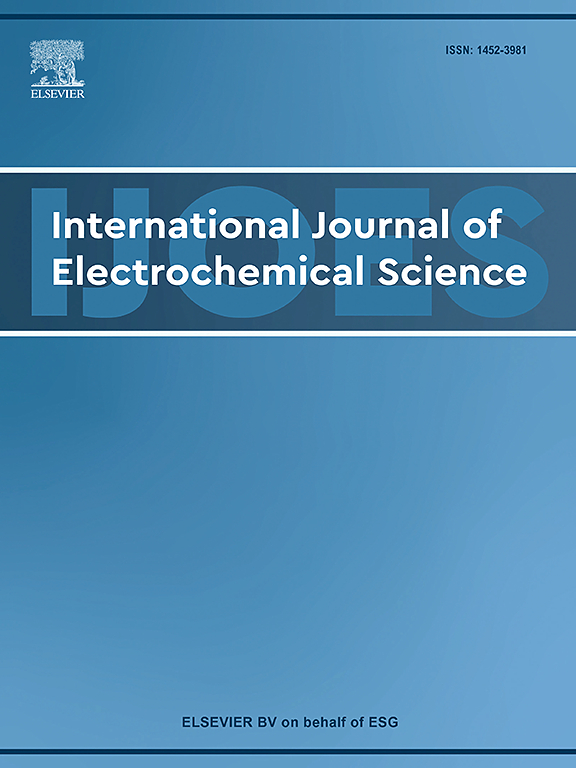Effect of Beta vulgaris L. extracts as an additive on the electrodeposition of zinc on mild steel in chloride solution: coating characterization and corrosion behavior in seawater
IF 2.4
4区 化学
Q4 ELECTROCHEMISTRY
International Journal of Electrochemical Science
Pub Date : 2025-06-21
DOI:10.1016/j.ijoes.2025.101104
引用次数: 0
Abstract
Mild steel (MS), characterized by its low carbon content (0.05–0.25 %), is widely used in various industries but is vulnerable to corrosion, which limits its durability. Zinc electroplating, a well-established technique to protect MS, involves the deposition of a thin layer of zinc onto a metal substrate. This forms a corrosion-resistant zinc coating. In this study, natural phenolic extracts from Beta vulgaris L., specifically methanolic (ME), dichloromethane (MDE), ethyl acetate (EAE), and n-butanol (BE) extracts, were analyzed via HPLC-DAD and utilized as eco-friendly additives in zinc electroplating baths composed of ZnCl2, KCl, and H3BO4, to improve the quality and corrosion resistance of zinc coatings on MS. Incorporation of these extracts into the plating bath significantly improved the quality of zinc deposits. The enhanced brightness and refined surface morphology observed through scanning electron microscopy (SEM) and profilometry not only indicate the enhanced quality of the coatings but also suggest potential applications in industries where aesthetics and surface finish are important. Gravimetric corrosion tests and electrochemical evaluations, including potentiodynamic polarization (PP) and electrochemical impedance spectroscopy (EIS), demonstrated that zinc coatings formed in the presence of Beta vulgaris L. extracts exhibited remarkable corrosion resistance compared to conventional coatings. In addition, density functional theory (DFT)-based calculations were performed to investigate the adsorption behavior and chemical reactivity of the main phenolic compounds identified. Theoretical results revealed that ellagic acid exhibits the highest chemical activity, highlighting its key role in improving deposition efficiency and corrosion protection. This research underscores the potential of Beta vulgaris L. phenolic extracts as sustainable, natural additives for enhancing zinc electroplating processes. This offers a novel, environmentally friendly approach, addressing both performance enhancement and sustainability, and instilling hope for a more sustainable future in industrial plating processes.
甜菜提取物作为添加剂对氯化物溶液中低碳钢电沉积锌的影响:涂层表征和海水腐蚀行为
低碳钢(MS)的特点是含碳量低(0.05-0.25 %),广泛应用于各个行业,但易受腐蚀,这限制了其耐久性。锌电镀是一种成熟的保护质谱的技术,它包括在金属衬底上沉积一层薄锌。这就形成了一层耐腐蚀的锌涂层。本研究通过HPLC-DAD分析了甜菜中天然酚类提取物,特别是甲醇(ME)、二氯甲烷(MDE)、乙酸乙酯(EAE)和正丁醇(BE)提取物,并将其作为环保型添加剂应用于由ZnCl2、KCl和H3BO4组成的锌电镀液中,以提高ms上锌镀层的质量和耐腐蚀性。通过扫描电子显微镜(SEM)和轮廓术观察到的增强的亮度和精细的表面形貌不仅表明涂层质量增强,而且表明在美学和表面光洁度很重要的工业中有潜在的应用。重量腐蚀试验和电化学评价(包括动电位极化(PP)和电化学阻抗谱(EIS))表明,与传统涂层相比,在甜菜提取物存在下形成的锌涂层具有显著的耐腐蚀性。此外,基于密度泛函理论(DFT)的计算研究了所鉴定的主要酚类化合物的吸附行为和化学反应性。理论结果表明,鞣花酸具有最高的化学活性,突出了其在提高沉积效率和防腐方面的关键作用。本研究强调了甜菜碱酚提取物作为可持续的天然添加剂的潜力,以提高锌电镀工艺。这提供了一种新颖、环保的方法,既解决了性能提高和可持续性问题,也为工业电镀工艺的可持续发展带来了希望。
本文章由计算机程序翻译,如有差异,请以英文原文为准。
求助全文
约1分钟内获得全文
求助全文
来源期刊
CiteScore
3.00
自引率
20.00%
发文量
714
审稿时长
2.6 months
期刊介绍:
International Journal of Electrochemical Science is a peer-reviewed, open access journal that publishes original research articles, short communications as well as review articles in all areas of electrochemistry: Scope - Theoretical and Computational Electrochemistry - Processes on Electrodes - Electroanalytical Chemistry and Sensor Science - Corrosion - Electrochemical Energy Conversion and Storage - Electrochemical Engineering - Coatings - Electrochemical Synthesis - Bioelectrochemistry - Molecular Electrochemistry

 求助内容:
求助内容: 应助结果提醒方式:
应助结果提醒方式:


